The Roman Camp
As an introduction to the topic of the Roman camp, we could not do better than this description from Livy. He puts this speech in the mouth of Aemilius Paullus just before the Battle of Pydna in the summer of 168 BC. Paullus is addressing his senior officers who are critical of his decision to construct a camp at the end of yesterday's march instead of attacking Perseus, the Macedonian King:
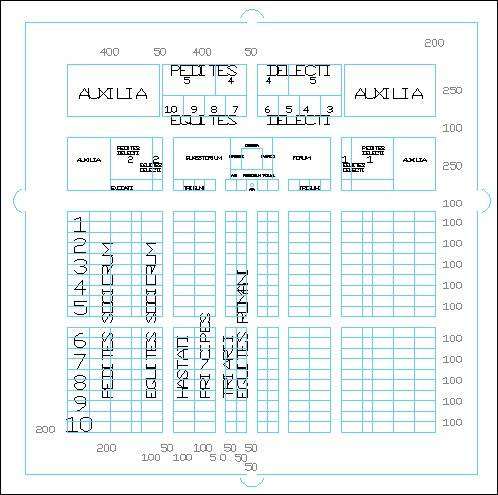 The legions were encamped toward the centre of the camp in the rows labelled Hastati, Principes and Triarii; one legion on either side of the centre line. The small Roman cavalry units, Equites Romani, were positioned along the centerline between the two legions.
The allies, Pedites Sociorum and Equites Sociorum were positioned outside of the legions.
The central area, just above the broad cross street, was for the general staff and several units of the Pedites and Equites Delecti. Additional auxiliary troops, Auxilia, were camped in the two upper corners.
The plan below also gives the dimensions of the units and streets.
The legions were encamped toward the centre of the camp in the rows labelled Hastati, Principes and Triarii; one legion on either side of the centre line. The small Roman cavalry units, Equites Romani, were positioned along the centerline between the two legions.
The allies, Pedites Sociorum and Equites Sociorum were positioned outside of the legions.
The central area, just above the broad cross street, was for the general staff and several units of the Pedites and Equites Delecti. Additional auxiliary troops, Auxilia, were camped in the two upper corners.
The plan below also gives the dimensions of the units and streets.
While most authors agree on the layout of the portion assigned to the legions, there are some differences in the way the upper portion of the camp is laid out. Four variations on that layout are given below.
 The small green squares represent tents. The tents of the tribunes can be seen across the street from the first maniple of each legion and auxiliary unit.
The walls and ditches around the camp are shown as standard 9' ditches with rounded corners. The ditch portion is black, the wall portion is red. There are 200 feet between the wall and the tenting areas.
Close up of the tenting areas for three maniples.
The small green squares represent tents. The tents of the tribunes can be seen across the street from the first maniple of each legion and auxiliary unit.
The walls and ditches around the camp are shown as standard 9' ditches with rounded corners. The ditch portion is black, the wall portion is red. There are 200 feet between the wall and the tenting areas.
Close up of the tenting areas for three maniples. Close up of the central area of the camp The Consul's tent was located in the middle of the camp with the Quaestor's tent to the left. The Tribunes tents are located along the Via Principis.
Close up of the central area of the camp The Consul's tent was located in the middle of the camp with the Quaestor's tent to the left. The Tribunes tents are located along the Via Principis.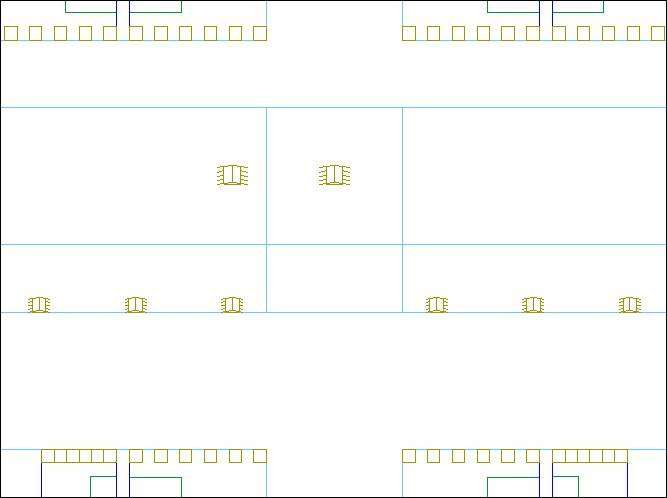
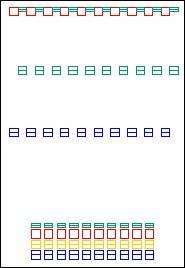 The drawing to the left shows one legion in a standard formation drawn to the same scale as the camp. The Hastati (blue) are at the bottom. Below the legion is a configuration of the same units in a tightly compressed formation that could have been used for manoeuvre. In the drawing below both Roman legions and both Auxiliary legions are shown in the tight formation drawn up inside the walls. The 200-foot intervallum, the space between the walls and the tenting area, would have just sufficed to accommodate the legions. Such a tight formation is not anywhere described but seems logical should the army have had to draw itself up for battle before leaving the shelter of the camp. The drawing shows one way this could have been done in the 200-foot intervallum were it necessary.
The drawing to the left shows one legion in a standard formation drawn to the same scale as the camp. The Hastati (blue) are at the bottom. Below the legion is a configuration of the same units in a tightly compressed formation that could have been used for manoeuvre. In the drawing below both Roman legions and both Auxiliary legions are shown in the tight formation drawn up inside the walls. The 200-foot intervallum, the space between the walls and the tenting area, would have just sufficed to accommodate the legions. Such a tight formation is not anywhere described but seems logical should the army have had to draw itself up for battle before leaving the shelter of the camp. The drawing shows one way this could have been done in the 200-foot intervallum were it necessary.
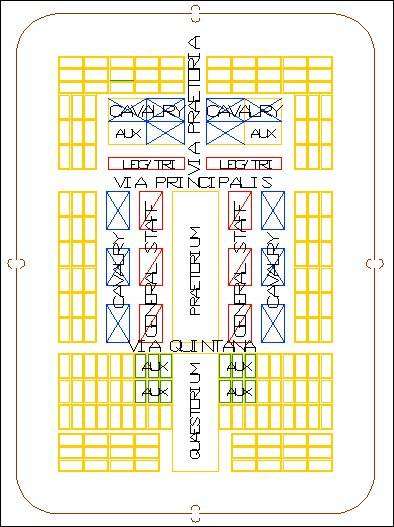 The plan below shows the location of each of the 5 legions and of each of the ten cohorts of the legions.
The plan below shows the location of each of the 5 legions and of each of the ten cohorts of the legions. The following plan shows the individual tenting areas for each legion.
The following plan shows the individual tenting areas for each legion. There are only minor variations in the plan given by different sources. The chief variation comes in the area sometimes assigned to auxiliary archers and slingers and sometimes assigned to legates and tribunes. These two plans are shown below.
There are only minor variations in the plan given by different sources. The chief variation comes in the area sometimes assigned to auxiliary archers and slingers and sometimes assigned to legates and tribunes. These two plans are shown below.
 As with the pre-Marius legion, it would have been possible for the legions to assemble in the intervallum if the walls were 200' from the tenting areas. The post-Marian legion is shown at the left, first in the standard formation and then, below, in a tightly compressed formation.
This drawing shows how the five legions could have been assembled in the intervallum.
As with the pre-Marius legion, it would have been possible for the legions to assemble in the intervallum if the walls were 200' from the tenting areas. The post-Marian legion is shown at the left, first in the standard formation and then, below, in a tightly compressed formation.
This drawing shows how the five legions could have been assembled in the intervallum.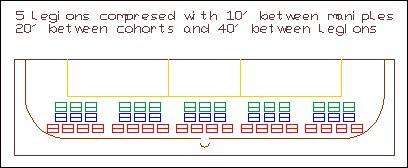 The distance between the tenting areas and the protective walls is given as anything from 60 feet to 200 feet. The camp itself is described as either square (as in the model for the pre-Marianlegion) or rectangular. The three camp footprints below show the rectangular camp with 100' and 200' spaces between the walls and tenting areas and, on the right, the same size camp as a square.
The distance between the tenting areas and the protective walls is given as anything from 60 feet to 200 feet. The camp itself is described as either square (as in the model for the pre-Marianlegion) or rectangular. The three camp footprints below show the rectangular camp with 100' and 200' spaces between the walls and tenting areas and, on the right, the same size camp as a square.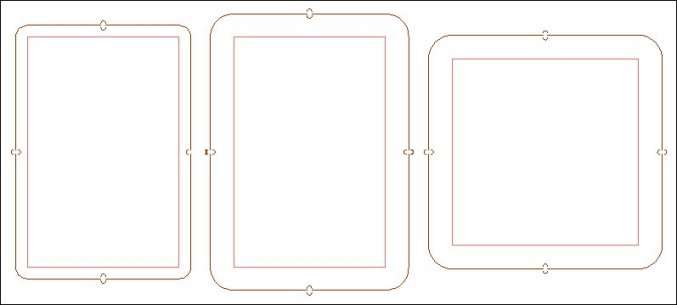
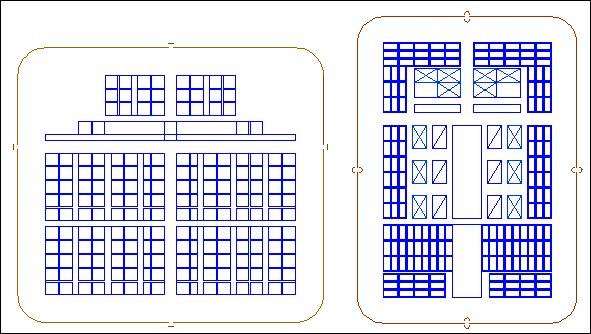
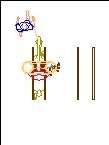 Each Contubernium is usually assigned a pack mule to carry the tent and other heavy gear, at least from the time of Marius on. A servant led the mule on the march and provided other services to the Contubernium. An overhead view of the servant and loaded mule is on the far left of the drawing. The mule carries the two tent poles, a folded tent, stakes, ropes, two baskets that will also be used in excavating the camp ditch, the digging tools, a small stone wheat grinder, and extra food.
Each Contubernium is usually assigned a pack mule to carry the tent and other heavy gear, at least from the time of Marius on. A servant led the mule on the march and provided other services to the Contubernium. An overhead view of the servant and loaded mule is on the far left of the drawing. The mule carries the two tent poles, a folded tent, stakes, ropes, two baskets that will also be used in excavating the camp ditch, the digging tools, a small stone wheat grinder, and extra food.
 The tent is shown in front, side and top views. Note the extension of the guy ropes. In some camp layouts, the tents are placed so closely together that the stakes would have to overlap. This is shown in the drawing on the right. While such a layout works in terms of space, the stakes would present an obstacle to anyone trying to walk between the tents, especially at night. Some descriptions would have arms and armour stacked behind the tents. In case of an emergency, the soldiers would have to don their armour and then move between tents to assemble in front. The crossed guy ropes and stakes would seem to present a serious hazard at night in this instance.
The tent is shown in front, side and top views. Note the extension of the guy ropes. In some camp layouts, the tents are placed so closely together that the stakes would have to overlap. This is shown in the drawing on the right. While such a layout works in terms of space, the stakes would present an obstacle to anyone trying to walk between the tents, especially at night. Some descriptions would have arms and armour stacked behind the tents. In case of an emergency, the soldiers would have to don their armour and then move between tents to assemble in front. The crossed guy ropes and stakes would seem to present a serious hazard at night in this instance.
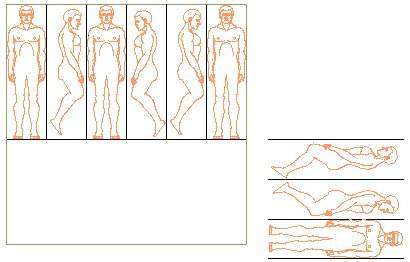 Sleeping arrangements: The 8 man tent is variously described as serving either 8 or 10 soldiers. Almost all descriptions state that 1/4 of the soldiers would have been on watch at any given time so that the tent would only have to sleep either 6 or 8 men. Some authors say that the legions, at least those after Marius' changes, had one mule assigned to each Contubernium to carry the tent and other heavy gear for the unit. In one version the servants are described as sharing the tent with the soldiers, increasing the number of occupants by one. In another, the servants of the century are described as grouped together in a tent of their own. Most camp descriptions do not fully consider the question of servants' tents.
The drawing at the left shows a tent 10 Roman Feet square with 6 sleeping positions across the back. There is not enough room for two rows. The three figures to the side are there to show that two, but not three, additional sleeping positions could be created by positioning them crosswise to the others.
The sleeping capacity of the tent would be a maximum of 8, leaving very little room inside for the storage of clothing or other gear that needed to be kept out of the weather. Given these considerations, it seems less likely that a tent could serve 10 soldiers. 8 would fit comfortably, sleeping 6 plus a servant and still leaving some room for clothing and other gear.
Sleeping arrangements: The 8 man tent is variously described as serving either 8 or 10 soldiers. Almost all descriptions state that 1/4 of the soldiers would have been on watch at any given time so that the tent would only have to sleep either 6 or 8 men. Some authors say that the legions, at least those after Marius' changes, had one mule assigned to each Contubernium to carry the tent and other heavy gear for the unit. In one version the servants are described as sharing the tent with the soldiers, increasing the number of occupants by one. In another, the servants of the century are described as grouped together in a tent of their own. Most camp descriptions do not fully consider the question of servants' tents.
The drawing at the left shows a tent 10 Roman Feet square with 6 sleeping positions across the back. There is not enough room for two rows. The three figures to the side are there to show that two, but not three, additional sleeping positions could be created by positioning them crosswise to the others.
The sleeping capacity of the tent would be a maximum of 8, leaving very little room inside for the storage of clothing or other gear that needed to be kept out of the weather. Given these considerations, it seems less likely that a tent could serve 10 soldiers. 8 would fit comfortably, sleeping 6 plus a servant and still leaving some room for clothing and other gear.

 The officer's tent is carried on a mule which has a servant assigned to it as well. Because of the larger size of the officer's tent there are more supporting poles. The mule would, presumably, have also carried food and other gear for the officer.
The officer's tent is carried on a mule which has a servant assigned to it as well. Because of the larger size of the officer's tent there are more supporting poles. The mule would, presumably, have also carried food and other gear for the officer.

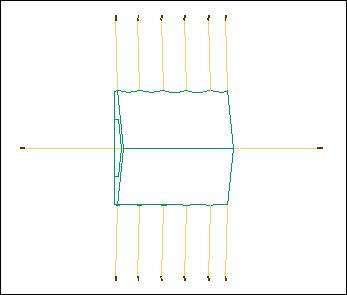
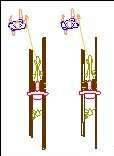 The overhead view of the general's tent is shown on the left. Note the length of the guy ropes. Because of the size of the tent, it would have been necessary to use a number of poles for its support. One arrangement is shown in the drawing below in which the poles have been colour-coded to make it easier to separate them. The poles could have been carried on two mules, the three yellow poles and half of the blue and red poles on one mule, the remainder on another. A tent of this size may have been carried on a cart or wagon. But wagons pulled by oxen were slow and limited in where they could travel. The tent could have been loaded onto several mules.
The overhead view of the general's tent is shown on the left. Note the length of the guy ropes. Because of the size of the tent, it would have been necessary to use a number of poles for its support. One arrangement is shown in the drawing below in which the poles have been colour-coded to make it easier to separate them. The poles could have been carried on two mules, the three yellow poles and half of the blue and red poles on one mule, the remainder on another. A tent of this size may have been carried on a cart or wagon. But wagons pulled by oxen were slow and limited in where they could travel. The tent could have been loaded onto several mules.
 Matthew Amt, a re-enactor, notes that the tent their group uses "... is made from 2 to 3-ounce goatskin c. 3/64" thick, and original remains are also goatskin. Three-ounce leather weighs 3 oz per square foot; ours weighs 50 pounds, being c. 10' square, 5' tall, with 14-inch walls." Based on his information the data for tents was revised. The table below shows some of the raw data, followed by updated drawings of each of the three sizes of tents.
Matthew Amt, a re-enactor, notes that the tent their group uses "... is made from 2 to 3-ounce goatskin c. 3/64" thick, and original remains are also goatskin. Three-ounce leather weighs 3 oz per square foot; ours weighs 50 pounds, being c. 10' square, 5' tall, with 14-inch walls." Based on his information the data for tents was revised. The table below shows some of the raw data, followed by updated drawings of each of the three sizes of tents.
The Contubernium tent with 12" sidewalls.
The officer's tent
The general's tent.
Matthew Amt also noted that "like most other groups that I know of, we use a ridgepole--ours is in 2 pieces with a scarf joint (fits into the car easier), supported by a third upright. A ridgepole saves the leather a lot of stress and makes the end ropes less necessary."

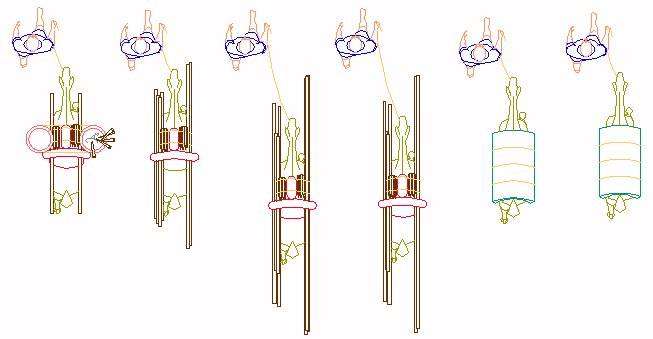
 The area assigned to the century is shown in the blue diagram as it is usually represented. The end tents would be assigned to the Centurions, the other tents to the Contubernium. The pack animals are sometimes shown staked in positions next to each ten, sometimes in a common "pasture" area. This particular diagram shows the pasture.
To the far right is the same unit with accurately drawn tents. It is clear that the ten tents do not fit in the area assigned because of the guy ropes.
This close-up view of the centurion's tent shows how the space required exceeds the squares drawn from the plan. The last three tents would not fit within the prescribed area because of the guy ropes. Nor could the tents be placed as close to the street as the plan would have them.
The area assigned to the century is shown in the blue diagram as it is usually represented. The end tents would be assigned to the Centurions, the other tents to the Contubernium. The pack animals are sometimes shown staked in positions next to each ten, sometimes in a common "pasture" area. This particular diagram shows the pasture.
To the far right is the same unit with accurately drawn tents. It is clear that the ten tents do not fit in the area assigned because of the guy ropes.
This close-up view of the centurion's tent shows how the space required exceeds the squares drawn from the plan. The last three tents would not fit within the prescribed area because of the guy ropes. Nor could the tents be placed as close to the street as the plan would have them.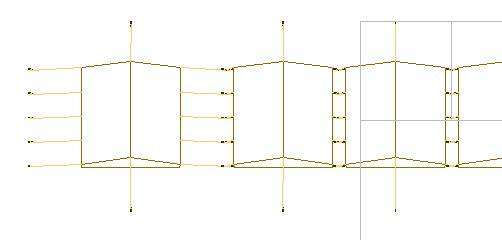 The illustration below shows the standard plan in light blue with actual tents overlaid. The plan on the left has standard tents, 10 Roman feet square. The plan in the middle reduces the tents to fit the plan. The plan on the right shows narrow tents, reduced to fit the space allowed, but elongated to provide the 100 square foot of space required for the Contubernium.
The illustration below shows the standard plan in light blue with actual tents overlaid. The plan on the left has standard tents, 10 Roman feet square. The plan in the middle reduces the tents to fit the plan. The plan on the right shows narrow tents, reduced to fit the space allowed, but elongated to provide the 100 square foot of space required for the Contubernium.
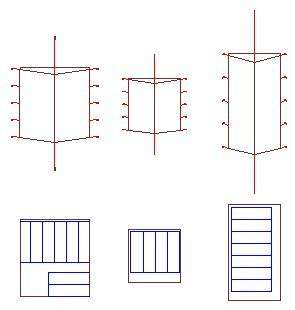 The close up on the left shows the three tent sizes used in the illustration above and possible arrangements of sleeping spaces. The 10-foot square tent could sleep a maximum of 8. The middle tent is only about 7 Roman feet square and could only sleep four people. The elongated tent, although it has the same area as the square tent, can only sleep 7.
All descriptions of the tent of the Contubernium have it as 10 Roman feet square. If it was, then the plans generally given for the republican legion layout do not provide sufficient space for the tents.
The plan of the later camp given by Connolly is shown below on the left with tents and mules overlaid in the drawing on the right.
The close up on the left shows the three tent sizes used in the illustration above and possible arrangements of sleeping spaces. The 10-foot square tent could sleep a maximum of 8. The middle tent is only about 7 Roman feet square and could only sleep four people. The elongated tent, although it has the same area as the square tent, can only sleep 7.
All descriptions of the tent of the Contubernium have it as 10 Roman feet square. If it was, then the plans generally given for the republican legion layout do not provide sufficient space for the tents.
The plan of the later camp given by Connolly is shown below on the left with tents and mules overlaid in the drawing on the right.
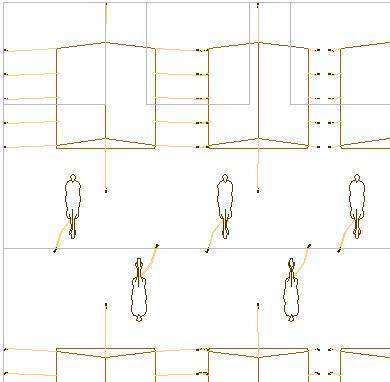 The close up drawing shows that the plan given by Connolly does provide sufficient space for the tents, although the blocks in the plan (grey squares) are placed too close to the street. The guy ropes extending from the ends of the tent would require a set back of almost 5 feet.
Since each Contubernium has a mule to carry the tent, space for the mules has to be provided as well. They are shown here as staked out between the tents.
The tent to the left is the Centurion's tent. Because of its higher sidewalls, it requires longer guy ropes to the sides. For this reason, it would have been set back from the street to the left further than the plan (grey square on the corner) shows.
The close up drawing shows that the plan given by Connolly does provide sufficient space for the tents, although the blocks in the plan (grey squares) are placed too close to the street. The guy ropes extending from the ends of the tent would require a set back of almost 5 feet.
Since each Contubernium has a mule to carry the tent, space for the mules has to be provided as well. They are shown here as staked out between the tents.
The tent to the left is the Centurion's tent. Because of its higher sidewalls, it requires longer guy ropes to the sides. For this reason, it would have been set back from the street to the left further than the plan (grey square on the corner) shows.
 The distance between the tenting area and the walls is given as between 60' and 200'. One's first reaction is that the greater distance would mean much greater distances to fortify. However, this is not the case, as the illustration on the right shows. The intervallum in the two fortifications is 100' and 200' respectively. The length of the straight parts of the fortifications necessary to enclose the tenting area is the same in both cases. The only increase in length is on the longer curve which is 78' instead of 39'. The extra 39' per corner would have been minor when compared to the overall length of the fortifications. The amount of time or effort involved in constructing the fortifications would not have presented a compelling reason to place the walls closer to the tenting areas. On the other hand, a greater distance would have provided increased safety from missiles and also provided more room for the legions to manoeuvre inside the walls before exiting through a gate.
The height of the wall depended on the looseness of the dirt when excavated and the type of trench being dug.
The distance between the tenting area and the walls is given as between 60' and 200'. One's first reaction is that the greater distance would mean much greater distances to fortify. However, this is not the case, as the illustration on the right shows. The intervallum in the two fortifications is 100' and 200' respectively. The length of the straight parts of the fortifications necessary to enclose the tenting area is the same in both cases. The only increase in length is on the longer curve which is 78' instead of 39'. The extra 39' per corner would have been minor when compared to the overall length of the fortifications. The amount of time or effort involved in constructing the fortifications would not have presented a compelling reason to place the walls closer to the tenting areas. On the other hand, a greater distance would have provided increased safety from missiles and also provided more room for the legions to manoeuvre inside the walls before exiting through a gate.
The height of the wall depended on the looseness of the dirt when excavated and the type of trench being dug.
 The Romans used three types of trenches, distinguished by the slope of the sides. The standard trench had two sloping sides. Caesar is said to have preferred trenches with vertical sides.
Dirt is said to expand approximately 1/6 of its volume when freshly dug. The volume of the trench and of the dirt when excavated are illustrated in the first two rows of the drawing.
The volume of dirt excavated from the different types of trenches and the resulting size of the walls it could build are illustrated in the drawing to the left. The top of the mound is 6' deep. The first line across the bottom is at a height of 6'. At this height, the wall would contain 57 cubic feet. At 7' the wall is 14' deep from front to back at the base and has a volume of 70.5 cubic feet. And at 8' it has 85.3 cubic feet. These three heights correspond to the three types of trenches.
The three panels below show some details of a standard 9' and 12' fortification. The width of the ditch determined the other dimensions of the fortification. Its depth was 2/3 of the width plus 1 foot. The amount of soil excavated depended on the type of ditch and soil conditions but would have been roughly proportionate to the width of the ditch.
The Romans used three types of trenches, distinguished by the slope of the sides. The standard trench had two sloping sides. Caesar is said to have preferred trenches with vertical sides.
Dirt is said to expand approximately 1/6 of its volume when freshly dug. The volume of the trench and of the dirt when excavated are illustrated in the first two rows of the drawing.
The volume of dirt excavated from the different types of trenches and the resulting size of the walls it could build are illustrated in the drawing to the left. The top of the mound is 6' deep. The first line across the bottom is at a height of 6'. At this height, the wall would contain 57 cubic feet. At 7' the wall is 14' deep from front to back at the base and has a volume of 70.5 cubic feet. And at 8' it has 85.3 cubic feet. These three heights correspond to the three types of trenches.
The three panels below show some details of a standard 9' and 12' fortification. The width of the ditch determined the other dimensions of the fortification. Its depth was 2/3 of the width plus 1 foot. The amount of soil excavated depended on the type of ditch and soil conditions but would have been roughly proportionate to the width of the ditch. The illustration on the left of the panel above shows a frontal view of the 12' fortification from the bottom of the ditch to the top of the palisade. The centre panel shows the 12' fortification, on the right is a 9' ditch which is often described as the more common one. The excavated sod used as a part of the foundation of the wall is shown in three views at the bottom of the right panel. Each sod is 1.5 feet long and 1' wide and 1/2 foot thick. Six sods could be cut across the 9' ditch. When stacked endwise to the wall they would face the first three feet of wall.
The fortifications are shown as reinforced with logs above the sod and on the backside. In many cases, this reinforcement would have been made up of fascines, of more sod cut from elsewhere, or simply of brush. The top of the wall is 6' wide from front to back, allowing enough room for several soldiers to manoeuvre.
Ditches of various sizes are described. Caesar seems to have employed larger ditches frequently. Five sizes of ditches and walls are shown in the illustration below. The parallel lines above the ditches represent a top view. The plans for the camps shown above were drawn with 9' trenches around them.
The illustration on the left of the panel above shows a frontal view of the 12' fortification from the bottom of the ditch to the top of the palisade. The centre panel shows the 12' fortification, on the right is a 9' ditch which is often described as the more common one. The excavated sod used as a part of the foundation of the wall is shown in three views at the bottom of the right panel. Each sod is 1.5 feet long and 1' wide and 1/2 foot thick. Six sods could be cut across the 9' ditch. When stacked endwise to the wall they would face the first three feet of wall.
The fortifications are shown as reinforced with logs above the sod and on the backside. In many cases, this reinforcement would have been made up of fascines, of more sod cut from elsewhere, or simply of brush. The top of the wall is 6' wide from front to back, allowing enough room for several soldiers to manoeuvre.
Ditches of various sizes are described. Caesar seems to have employed larger ditches frequently. Five sizes of ditches and walls are shown in the illustration below. The parallel lines above the ditches represent a top view. The plans for the camps shown above were drawn with 9' trenches around them.
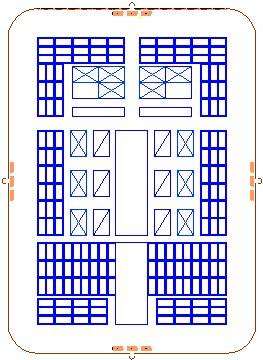 The camp was guarded by placing soldiers along the walls and a Cohort at each of the four gates. The drawing to the right shows the camp with one Cohort deployed at each gate. Along the wall at the top, a line of soldiers is deployed.
The drawing below shows a close up of that. The line of soldiers along the wall, shoulder to shoulder, can just be made out at this scale.
The camp was guarded by placing soldiers along the walls and a Cohort at each of the four gates. The drawing to the right shows the camp with one Cohort deployed at each gate. Along the wall at the top, a line of soldiers is deployed.
The drawing below shows a close up of that. The line of soldiers along the wall, shoulder to shoulder, can just be made out at this scale. This camp is comprised of 5 legions of 3,600 men each, a total of 18,000 legionaries plus auxiliaries. It is usually said that 1/4 of the soldiers were on guard duty at a time, for this camp that would be 4,500 at a time. The four Cohorts would account for 1,440 men, leaving 3,060 men to guard the walls. The circuit of the walls is 6,852 feet. Placing all 3,060 men along the walls puts them 2'3" apart, literally shoulder to shoulder. This is not close to the general description of one guard every 30' or so.
A cohort or two could have been kept in reserves in the centre of the camp, reducing the number along the walls to some extent. A two-cohort reserve would only increase the spacing on the wall to 2'10".Nevertheless, it seems unrealistic to have that many soldiers along the walls under routine circumstances. Yet, if 25% of the force were not on guard duty there would be problems finding sleeping room for all of the men in the tents.
This camp is comprised of 5 legions of 3,600 men each, a total of 18,000 legionaries plus auxiliaries. It is usually said that 1/4 of the soldiers were on guard duty at a time, for this camp that would be 4,500 at a time. The four Cohorts would account for 1,440 men, leaving 3,060 men to guard the walls. The circuit of the walls is 6,852 feet. Placing all 3,060 men along the walls puts them 2'3" apart, literally shoulder to shoulder. This is not close to the general description of one guard every 30' or so.
A cohort or two could have been kept in reserves in the centre of the camp, reducing the number along the walls to some extent. A two-cohort reserve would only increase the spacing on the wall to 2'10".Nevertheless, it seems unrealistic to have that many soldiers along the walls under routine circumstances. Yet, if 25% of the force were not on guard duty there would be problems finding sleeping room for all of the men in the tents.
Your ancestors looked upon a camp as a safe haven for the army against every mischance, from which they went out to battle, where, after being tossed in the storm of battle, they could find a safe retreat. It was for that reason that after they had fenced it with earthworks, they strengthened it with a powerful guard, for he who lost his camp, even if victorious on the field, was held to be defeated. A camp is a resting-place for the victor, a shelter for the vanquished. How many armies to whom the fortune of battle has proved unkindly have been driven inside their ramparts and then at their own time, sometimes almost immediately, have made a sortie and repulsed their victorious foe? Here is the soldier's second fatherland, here is his abode, with the rampart for its walls; here each finds in his tent, his home and his household gods. Ought we to have fought as homeless wanderers with no place to receive us after our victory? (Livy, 44.39)
The Pre-Marian Camp
Before Marius, the typical army was comprised of two Roman Legions and two Legions drafted from Rome's allies. A typical camp of this type is shown in the drawing below. The legions were encamped toward the centre of the camp in the rows labelled Hastati, Principes and Triarii; one legion on either side of the centre line. The small Roman cavalry units, Equites Romani, were positioned along the centerline between the two legions.
The allies, Pedites Sociorum and Equites Sociorum were positioned outside of the legions.
The central area, just above the broad cross street, was for the general staff and several units of the Pedites and Equites Delecti. Additional auxiliary troops, Auxilia, were camped in the two upper corners.
The plan below also gives the dimensions of the units and streets.
The legions were encamped toward the centre of the camp in the rows labelled Hastati, Principes and Triarii; one legion on either side of the centre line. The small Roman cavalry units, Equites Romani, were positioned along the centerline between the two legions.
The allies, Pedites Sociorum and Equites Sociorum were positioned outside of the legions.
The central area, just above the broad cross street, was for the general staff and several units of the Pedites and Equites Delecti. Additional auxiliary troops, Auxilia, were camped in the two upper corners.
The plan below also gives the dimensions of the units and streets.
Detail of the central area occupied by the general staff
 Four variations on the general plan
Four variations on the general plan
While most authors agree on the layout of the portion assigned to the legions, there are some differences in the way the upper portion of the camp is laid out. Four variations on that layout are given below.
The Early Camp According to Connolly
Peter Connolly gives a particularly good description of the early camp. A model based on his plan is shown below. The small green squares represent tents. The tents of the tribunes can be seen across the street from the first maniple of each legion and auxiliary unit.
The walls and ditches around the camp are shown as standard 9' ditches with rounded corners. The ditch portion is black, the wall portion is red. There are 200 feet between the wall and the tenting areas.
Close up of the tenting areas for three maniples.
The small green squares represent tents. The tents of the tribunes can be seen across the street from the first maniple of each legion and auxiliary unit.
The walls and ditches around the camp are shown as standard 9' ditches with rounded corners. The ditch portion is black, the wall portion is red. There are 200 feet between the wall and the tenting areas.
Close up of the tenting areas for three maniples. Close up of the central area of the camp The Consul's tent was located in the middle of the camp with the Quaestor's tent to the left. The Tribunes tents are located along the Via Principis.
Close up of the central area of the camp The Consul's tent was located in the middle of the camp with the Quaestor's tent to the left. The Tribunes tents are located along the Via Principis.
 The drawing to the left shows one legion in a standard formation drawn to the same scale as the camp. The Hastati (blue) are at the bottom. Below the legion is a configuration of the same units in a tightly compressed formation that could have been used for manoeuvre. In the drawing below both Roman legions and both Auxiliary legions are shown in the tight formation drawn up inside the walls. The 200-foot intervallum, the space between the walls and the tenting area, would have just sufficed to accommodate the legions. Such a tight formation is not anywhere described but seems logical should the army have had to draw itself up for battle before leaving the shelter of the camp. The drawing shows one way this could have been done in the 200-foot intervallum were it necessary.
The drawing to the left shows one legion in a standard formation drawn to the same scale as the camp. The Hastati (blue) are at the bottom. Below the legion is a configuration of the same units in a tightly compressed formation that could have been used for manoeuvre. In the drawing below both Roman legions and both Auxiliary legions are shown in the tight formation drawn up inside the walls. The 200-foot intervallum, the space between the walls and the tenting area, would have just sufficed to accommodate the legions. Such a tight formation is not anywhere described but seems logical should the army have had to draw itself up for battle before leaving the shelter of the camp. The drawing shows one way this could have been done in the 200-foot intervallum were it necessary.
The Post-Marian Camp
The plan for the post-Marian legion is usually given as a rectangular camp for 5 legions. The general plan of the camp and the names of the units is shown in the plan below. The plan below shows the location of each of the 5 legions and of each of the ten cohorts of the legions.
The plan below shows the location of each of the 5 legions and of each of the ten cohorts of the legions. The following plan shows the individual tenting areas for each legion.
The following plan shows the individual tenting areas for each legion. There are only minor variations in the plan given by different sources. The chief variation comes in the area sometimes assigned to auxiliary archers and slingers and sometimes assigned to legates and tribunes. These two plans are shown below.
There are only minor variations in the plan given by different sources. The chief variation comes in the area sometimes assigned to auxiliary archers and slingers and sometimes assigned to legates and tribunes. These two plans are shown below.
 As with the pre-Marius legion, it would have been possible for the legions to assemble in the intervallum if the walls were 200' from the tenting areas. The post-Marian legion is shown at the left, first in the standard formation and then, below, in a tightly compressed formation.
This drawing shows how the five legions could have been assembled in the intervallum.
As with the pre-Marius legion, it would have been possible for the legions to assemble in the intervallum if the walls were 200' from the tenting areas. The post-Marian legion is shown at the left, first in the standard formation and then, below, in a tightly compressed formation.
This drawing shows how the five legions could have been assembled in the intervallum. The distance between the tenting areas and the protective walls is given as anything from 60 feet to 200 feet. The camp itself is described as either square (as in the model for the pre-Marianlegion) or rectangular. The three camp footprints below show the rectangular camp with 100' and 200' spaces between the walls and tenting areas and, on the right, the same size camp as a square.
The distance between the tenting areas and the protective walls is given as anything from 60 feet to 200 feet. The camp itself is described as either square (as in the model for the pre-Marianlegion) or rectangular. The three camp footprints below show the rectangular camp with 100' and 200' spaces between the walls and tenting areas and, on the right, the same size camp as a square.
The Two Types of Camps Compared
The pre-Marian camp housed four legions plus auxiliary. The post-Marian legion was for five legions plus auxiliary. Surprisingly, when the two camps are drawn to the same scale the later camp is smaller. The authors consulted do not seem to have recognized this oddity, so it is not known if the discrepancy is real or is an error. Yet it does seem odd that the larger army occupied a much smaller area. The two camps are drawn to the same scale.
Three Types of Tents
The 8 man tent group was called a Contubernium. It seems to have formed a basic unit of the Roman army throughout its history. It is 10 Roman feet square and about 5 Roman feet tall. For comparison, the figures used in the drawings are 5'6". Each Contubernium is usually assigned a pack mule to carry the tent and other heavy gear, at least from the time of Marius on. A servant led the mule on the march and provided other services to the Contubernium. An overhead view of the servant and loaded mule is on the far left of the drawing. The mule carries the two tent poles, a folded tent, stakes, ropes, two baskets that will also be used in excavating the camp ditch, the digging tools, a small stone wheat grinder, and extra food.
Each Contubernium is usually assigned a pack mule to carry the tent and other heavy gear, at least from the time of Marius on. A servant led the mule on the march and provided other services to the Contubernium. An overhead view of the servant and loaded mule is on the far left of the drawing. The mule carries the two tent poles, a folded tent, stakes, ropes, two baskets that will also be used in excavating the camp ditch, the digging tools, a small stone wheat grinder, and extra food.
 The tent is shown in front, side and top views. Note the extension of the guy ropes. In some camp layouts, the tents are placed so closely together that the stakes would have to overlap. This is shown in the drawing on the right. While such a layout works in terms of space, the stakes would present an obstacle to anyone trying to walk between the tents, especially at night. Some descriptions would have arms and armour stacked behind the tents. In case of an emergency, the soldiers would have to don their armour and then move between tents to assemble in front. The crossed guy ropes and stakes would seem to present a serious hazard at night in this instance.
The tent is shown in front, side and top views. Note the extension of the guy ropes. In some camp layouts, the tents are placed so closely together that the stakes would have to overlap. This is shown in the drawing on the right. While such a layout works in terms of space, the stakes would present an obstacle to anyone trying to walk between the tents, especially at night. Some descriptions would have arms and armour stacked behind the tents. In case of an emergency, the soldiers would have to don their armour and then move between tents to assemble in front. The crossed guy ropes and stakes would seem to present a serious hazard at night in this instance.
 Sleeping arrangements: The 8 man tent is variously described as serving either 8 or 10 soldiers. Almost all descriptions state that 1/4 of the soldiers would have been on watch at any given time so that the tent would only have to sleep either 6 or 8 men. Some authors say that the legions, at least those after Marius' changes, had one mule assigned to each Contubernium to carry the tent and other heavy gear for the unit. In one version the servants are described as sharing the tent with the soldiers, increasing the number of occupants by one. In another, the servants of the century are described as grouped together in a tent of their own. Most camp descriptions do not fully consider the question of servants' tents.
The drawing at the left shows a tent 10 Roman Feet square with 6 sleeping positions across the back. There is not enough room for two rows. The three figures to the side are there to show that two, but not three, additional sleeping positions could be created by positioning them crosswise to the others.
The sleeping capacity of the tent would be a maximum of 8, leaving very little room inside for the storage of clothing or other gear that needed to be kept out of the weather. Given these considerations, it seems less likely that a tent could serve 10 soldiers. 8 would fit comfortably, sleeping 6 plus a servant and still leaving some room for clothing and other gear.
Sleeping arrangements: The 8 man tent is variously described as serving either 8 or 10 soldiers. Almost all descriptions state that 1/4 of the soldiers would have been on watch at any given time so that the tent would only have to sleep either 6 or 8 men. Some authors say that the legions, at least those after Marius' changes, had one mule assigned to each Contubernium to carry the tent and other heavy gear for the unit. In one version the servants are described as sharing the tent with the soldiers, increasing the number of occupants by one. In another, the servants of the century are described as grouped together in a tent of their own. Most camp descriptions do not fully consider the question of servants' tents.
The drawing at the left shows a tent 10 Roman Feet square with 6 sleeping positions across the back. There is not enough room for two rows. The three figures to the side are there to show that two, but not three, additional sleeping positions could be created by positioning them crosswise to the others.
The sleeping capacity of the tent would be a maximum of 8, leaving very little room inside for the storage of clothing or other gear that needed to be kept out of the weather. Given these considerations, it seems less likely that a tent could serve 10 soldiers. 8 would fit comfortably, sleeping 6 plus a servant and still leaving some room for clothing and other gear.
An Officer's Tent
According to most sources, the Centurions each had their own tent. That shown here follows Connolly. Since the Centurion also used his tent as an office the higher sidewalls would have given the needed headroom. The tent shown here is also 10 Roman feet square but occupies more space because of the longer guy ropes. There are also more tent poles -- two centre poles and 4 corner poles.
 The officer's tent is carried on a mule which has a servant assigned to it as well. Because of the larger size of the officer's tent there are more supporting poles. The mule would, presumably, have also carried food and other gear for the officer.
The officer's tent is carried on a mule which has a servant assigned to it as well. Because of the larger size of the officer's tent there are more supporting poles. The mule would, presumably, have also carried food and other gear for the officer.
The General's Tent
The general and, perhaps, other senior officers are shown with much larger tents. The tent shown here is 12 Roman feet square. The side walls are 9' high, the peak is 12' high.

 The overhead view of the general's tent is shown on the left. Note the length of the guy ropes. Because of the size of the tent, it would have been necessary to use a number of poles for its support. One arrangement is shown in the drawing below in which the poles have been colour-coded to make it easier to separate them. The poles could have been carried on two mules, the three yellow poles and half of the blue and red poles on one mule, the remainder on another. A tent of this size may have been carried on a cart or wagon. But wagons pulled by oxen were slow and limited in where they could travel. The tent could have been loaded onto several mules.
The overhead view of the general's tent is shown on the left. Note the length of the guy ropes. Because of the size of the tent, it would have been necessary to use a number of poles for its support. One arrangement is shown in the drawing below in which the poles have been colour-coded to make it easier to separate them. The poles could have been carried on two mules, the three yellow poles and half of the blue and red poles on one mule, the remainder on another. A tent of this size may have been carried on a cart or wagon. But wagons pulled by oxen were slow and limited in where they could travel. The tent could have been loaded onto several mules.
 Matthew Amt, a re-enactor, notes that the tent their group uses "... is made from 2 to 3-ounce goatskin c. 3/64" thick, and original remains are also goatskin. Three-ounce leather weighs 3 oz per square foot; ours weighs 50 pounds, being c. 10' square, 5' tall, with 14-inch walls." Based on his information the data for tents was revised. The table below shows some of the raw data, followed by updated drawings of each of the three sizes of tents.
Matthew Amt, a re-enactor, notes that the tent their group uses "... is made from 2 to 3-ounce goatskin c. 3/64" thick, and original remains are also goatskin. Three-ounce leather weighs 3 oz per square foot; ours weighs 50 pounds, being c. 10' square, 5' tall, with 14-inch walls." Based on his information the data for tents was revised. The table below shows some of the raw data, followed by updated drawings of each of the three sizes of tents.
The Contubernium tent with 12" sidewalls.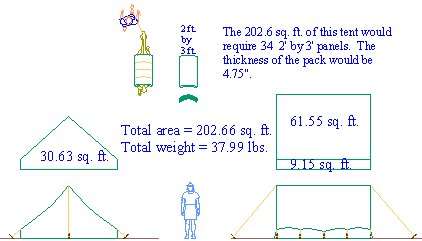
The officer's tent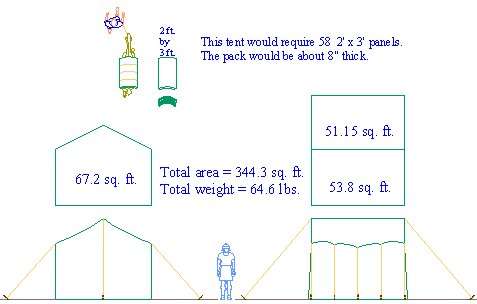
The general's tent.
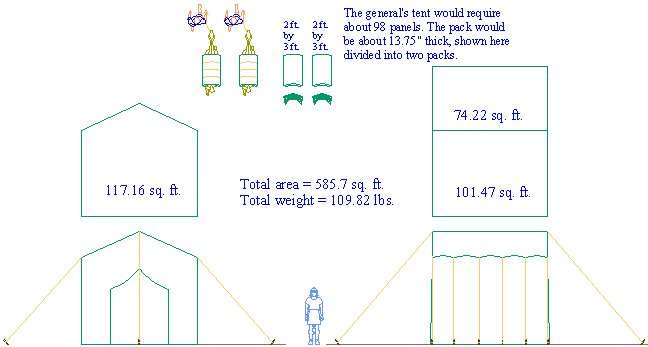
Matthew Amt also noted that "like most other groups that I know of, we use a ridgepole--ours is in 2 pieces with a scarf joint (fits into the car easier), supported by a third upright. A ridgepole saves the leather a lot of stress and makes the end ropes less necessary."

Detail of the Pack Mules
The following drawing shows the 6 mules described above and how their loads may have differed. On the left is the mule for the Contubernium with its baskets, short poles, and tools. The next is that for the Centurion. The four on the right are those for the general's tent, two for the poles and two for the tent itself.
The Layout of the Camp Area Assigned to Each Maniple
 The area assigned to the century is shown in the blue diagram as it is usually represented. The end tents would be assigned to the Centurions, the other tents to the Contubernium. The pack animals are sometimes shown staked in positions next to each ten, sometimes in a common "pasture" area. This particular diagram shows the pasture.
To the far right is the same unit with accurately drawn tents. It is clear that the ten tents do not fit in the area assigned because of the guy ropes.
This close-up view of the centurion's tent shows how the space required exceeds the squares drawn from the plan. The last three tents would not fit within the prescribed area because of the guy ropes. Nor could the tents be placed as close to the street as the plan would have them.
The area assigned to the century is shown in the blue diagram as it is usually represented. The end tents would be assigned to the Centurions, the other tents to the Contubernium. The pack animals are sometimes shown staked in positions next to each ten, sometimes in a common "pasture" area. This particular diagram shows the pasture.
To the far right is the same unit with accurately drawn tents. It is clear that the ten tents do not fit in the area assigned because of the guy ropes.
This close-up view of the centurion's tent shows how the space required exceeds the squares drawn from the plan. The last three tents would not fit within the prescribed area because of the guy ropes. Nor could the tents be placed as close to the street as the plan would have them. The illustration below shows the standard plan in light blue with actual tents overlaid. The plan on the left has standard tents, 10 Roman feet square. The plan in the middle reduces the tents to fit the plan. The plan on the right shows narrow tents, reduced to fit the space allowed, but elongated to provide the 100 square foot of space required for the Contubernium.
The illustration below shows the standard plan in light blue with actual tents overlaid. The plan on the left has standard tents, 10 Roman feet square. The plan in the middle reduces the tents to fit the plan. The plan on the right shows narrow tents, reduced to fit the space allowed, but elongated to provide the 100 square foot of space required for the Contubernium.
 The close up on the left shows the three tent sizes used in the illustration above and possible arrangements of sleeping spaces. The 10-foot square tent could sleep a maximum of 8. The middle tent is only about 7 Roman feet square and could only sleep four people. The elongated tent, although it has the same area as the square tent, can only sleep 7.
All descriptions of the tent of the Contubernium have it as 10 Roman feet square. If it was, then the plans generally given for the republican legion layout do not provide sufficient space for the tents.
The plan of the later camp given by Connolly is shown below on the left with tents and mules overlaid in the drawing on the right.
The close up on the left shows the three tent sizes used in the illustration above and possible arrangements of sleeping spaces. The 10-foot square tent could sleep a maximum of 8. The middle tent is only about 7 Roman feet square and could only sleep four people. The elongated tent, although it has the same area as the square tent, can only sleep 7.
All descriptions of the tent of the Contubernium have it as 10 Roman feet square. If it was, then the plans generally given for the republican legion layout do not provide sufficient space for the tents.
The plan of the later camp given by Connolly is shown below on the left with tents and mules overlaid in the drawing on the right.
 The close up drawing shows that the plan given by Connolly does provide sufficient space for the tents, although the blocks in the plan (grey squares) are placed too close to the street. The guy ropes extending from the ends of the tent would require a set back of almost 5 feet.
Since each Contubernium has a mule to carry the tent, space for the mules has to be provided as well. They are shown here as staked out between the tents.
The tent to the left is the Centurion's tent. Because of its higher sidewalls, it requires longer guy ropes to the sides. For this reason, it would have been set back from the street to the left further than the plan (grey square on the corner) shows.
The close up drawing shows that the plan given by Connolly does provide sufficient space for the tents, although the blocks in the plan (grey squares) are placed too close to the street. The guy ropes extending from the ends of the tent would require a set back of almost 5 feet.
Since each Contubernium has a mule to carry the tent, space for the mules has to be provided as well. They are shown here as staked out between the tents.
The tent to the left is the Centurion's tent. Because of its higher sidewalls, it requires longer guy ropes to the sides. For this reason, it would have been set back from the street to the left further than the plan (grey square on the corner) shows.
Adjustments to Standard Descriptions
If the models of the tents of the Contubernium and the centurion are accurate, then there would appear to be several difficulties with the standard descriptions of the Roman camps. The legion formation usually described for the time of Scipio Africanus is 4,200 strong with centuries of 60 men. At 10 to the tent, the century would require 6 tents for the soldiers, 1 for the servants and one for the Centurion. The plans usually drawn for these legions show 11 tents to the plot but in actuality, only 8 would have fitted into the space. If there were, indeed, 11 tents then the size of the century would likely be larger. Certainly, the size of the space allotted to the century would have to increase by about 135%, from 110' to 150'. The legions of Marius and later times are described as having a nominal strength of 4,800 men with centuries of 80 men each. At 10 to the tent, this century would require 8 tents for the soldiers, one for the servants and one for the centurion. At 8 men to the tent the servants could have shared the tent; there would have to have been 10 tents plus one for the centurion. The plan drawn by Connolly shows only 8 tents for the century. This would be suitable for an understrength legion. Caesar is often described as employing legions of 3,600 men with 60 men to the century. As seen above, a 60 man century can be accommodated in 8 tents.Camp Fortification
 The distance between the tenting area and the walls is given as between 60' and 200'. One's first reaction is that the greater distance would mean much greater distances to fortify. However, this is not the case, as the illustration on the right shows. The intervallum in the two fortifications is 100' and 200' respectively. The length of the straight parts of the fortifications necessary to enclose the tenting area is the same in both cases. The only increase in length is on the longer curve which is 78' instead of 39'. The extra 39' per corner would have been minor when compared to the overall length of the fortifications. The amount of time or effort involved in constructing the fortifications would not have presented a compelling reason to place the walls closer to the tenting areas. On the other hand, a greater distance would have provided increased safety from missiles and also provided more room for the legions to manoeuvre inside the walls before exiting through a gate.
The height of the wall depended on the looseness of the dirt when excavated and the type of trench being dug.
The distance between the tenting area and the walls is given as between 60' and 200'. One's first reaction is that the greater distance would mean much greater distances to fortify. However, this is not the case, as the illustration on the right shows. The intervallum in the two fortifications is 100' and 200' respectively. The length of the straight parts of the fortifications necessary to enclose the tenting area is the same in both cases. The only increase in length is on the longer curve which is 78' instead of 39'. The extra 39' per corner would have been minor when compared to the overall length of the fortifications. The amount of time or effort involved in constructing the fortifications would not have presented a compelling reason to place the walls closer to the tenting areas. On the other hand, a greater distance would have provided increased safety from missiles and also provided more room for the legions to manoeuvre inside the walls before exiting through a gate.
The height of the wall depended on the looseness of the dirt when excavated and the type of trench being dug.
 The Romans used three types of trenches, distinguished by the slope of the sides. The standard trench had two sloping sides. Caesar is said to have preferred trenches with vertical sides.
Dirt is said to expand approximately 1/6 of its volume when freshly dug. The volume of the trench and of the dirt when excavated are illustrated in the first two rows of the drawing.
The volume of dirt excavated from the different types of trenches and the resulting size of the walls it could build are illustrated in the drawing to the left. The top of the mound is 6' deep. The first line across the bottom is at a height of 6'. At this height, the wall would contain 57 cubic feet. At 7' the wall is 14' deep from front to back at the base and has a volume of 70.5 cubic feet. And at 8' it has 85.3 cubic feet. These three heights correspond to the three types of trenches.
The three panels below show some details of a standard 9' and 12' fortification. The width of the ditch determined the other dimensions of the fortification. Its depth was 2/3 of the width plus 1 foot. The amount of soil excavated depended on the type of ditch and soil conditions but would have been roughly proportionate to the width of the ditch.
The Romans used three types of trenches, distinguished by the slope of the sides. The standard trench had two sloping sides. Caesar is said to have preferred trenches with vertical sides.
Dirt is said to expand approximately 1/6 of its volume when freshly dug. The volume of the trench and of the dirt when excavated are illustrated in the first two rows of the drawing.
The volume of dirt excavated from the different types of trenches and the resulting size of the walls it could build are illustrated in the drawing to the left. The top of the mound is 6' deep. The first line across the bottom is at a height of 6'. At this height, the wall would contain 57 cubic feet. At 7' the wall is 14' deep from front to back at the base and has a volume of 70.5 cubic feet. And at 8' it has 85.3 cubic feet. These three heights correspond to the three types of trenches.
The three panels below show some details of a standard 9' and 12' fortification. The width of the ditch determined the other dimensions of the fortification. Its depth was 2/3 of the width plus 1 foot. The amount of soil excavated depended on the type of ditch and soil conditions but would have been roughly proportionate to the width of the ditch. The illustration on the left of the panel above shows a frontal view of the 12' fortification from the bottom of the ditch to the top of the palisade. The centre panel shows the 12' fortification, on the right is a 9' ditch which is often described as the more common one. The excavated sod used as a part of the foundation of the wall is shown in three views at the bottom of the right panel. Each sod is 1.5 feet long and 1' wide and 1/2 foot thick. Six sods could be cut across the 9' ditch. When stacked endwise to the wall they would face the first three feet of wall.
The fortifications are shown as reinforced with logs above the sod and on the backside. In many cases, this reinforcement would have been made up of fascines, of more sod cut from elsewhere, or simply of brush. The top of the wall is 6' wide from front to back, allowing enough room for several soldiers to manoeuvre.
Ditches of various sizes are described. Caesar seems to have employed larger ditches frequently. Five sizes of ditches and walls are shown in the illustration below. The parallel lines above the ditches represent a top view. The plans for the camps shown above were drawn with 9' trenches around them.
The illustration on the left of the panel above shows a frontal view of the 12' fortification from the bottom of the ditch to the top of the palisade. The centre panel shows the 12' fortification, on the right is a 9' ditch which is often described as the more common one. The excavated sod used as a part of the foundation of the wall is shown in three views at the bottom of the right panel. Each sod is 1.5 feet long and 1' wide and 1/2 foot thick. Six sods could be cut across the 9' ditch. When stacked endwise to the wall they would face the first three feet of wall.
The fortifications are shown as reinforced with logs above the sod and on the backside. In many cases, this reinforcement would have been made up of fascines, of more sod cut from elsewhere, or simply of brush. The top of the wall is 6' wide from front to back, allowing enough room for several soldiers to manoeuvre.
Ditches of various sizes are described. Caesar seems to have employed larger ditches frequently. Five sizes of ditches and walls are shown in the illustration below. The parallel lines above the ditches represent a top view. The plans for the camps shown above were drawn with 9' trenches around them.
 The camp was guarded by placing soldiers along the walls and a Cohort at each of the four gates. The drawing to the right shows the camp with one Cohort deployed at each gate. Along the wall at the top, a line of soldiers is deployed.
The drawing below shows a close up of that. The line of soldiers along the wall, shoulder to shoulder, can just be made out at this scale.
The camp was guarded by placing soldiers along the walls and a Cohort at each of the four gates. The drawing to the right shows the camp with one Cohort deployed at each gate. Along the wall at the top, a line of soldiers is deployed.
The drawing below shows a close up of that. The line of soldiers along the wall, shoulder to shoulder, can just be made out at this scale. This camp is comprised of 5 legions of 3,600 men each, a total of 18,000 legionaries plus auxiliaries. It is usually said that 1/4 of the soldiers were on guard duty at a time, for this camp that would be 4,500 at a time. The four Cohorts would account for 1,440 men, leaving 3,060 men to guard the walls. The circuit of the walls is 6,852 feet. Placing all 3,060 men along the walls puts them 2'3" apart, literally shoulder to shoulder. This is not close to the general description of one guard every 30' or so.
A cohort or two could have been kept in reserves in the centre of the camp, reducing the number along the walls to some extent. A two-cohort reserve would only increase the spacing on the wall to 2'10".Nevertheless, it seems unrealistic to have that many soldiers along the walls under routine circumstances. Yet, if 25% of the force were not on guard duty there would be problems finding sleeping room for all of the men in the tents.
This camp is comprised of 5 legions of 3,600 men each, a total of 18,000 legionaries plus auxiliaries. It is usually said that 1/4 of the soldiers were on guard duty at a time, for this camp that would be 4,500 at a time. The four Cohorts would account for 1,440 men, leaving 3,060 men to guard the walls. The circuit of the walls is 6,852 feet. Placing all 3,060 men along the walls puts them 2'3" apart, literally shoulder to shoulder. This is not close to the general description of one guard every 30' or so.
A cohort or two could have been kept in reserves in the centre of the camp, reducing the number along the walls to some extent. A two-cohort reserve would only increase the spacing on the wall to 2'10".Nevertheless, it seems unrealistic to have that many soldiers along the walls under routine circumstances. Yet, if 25% of the force were not on guard duty there would be problems finding sleeping room for all of the men in the tents.
